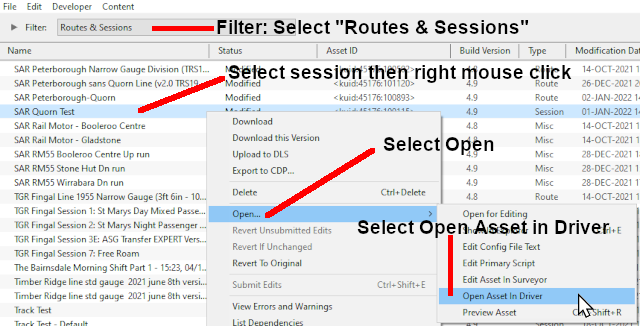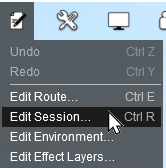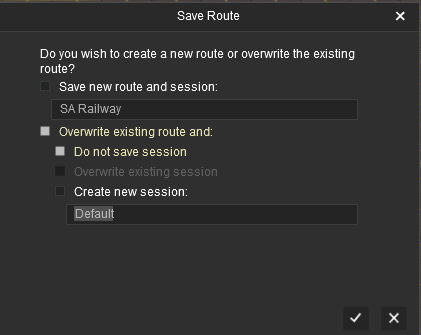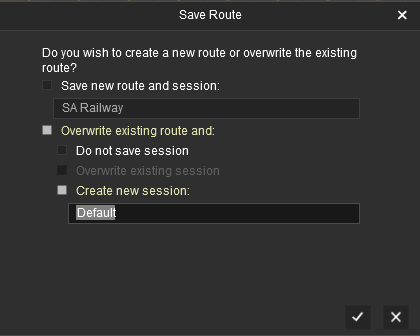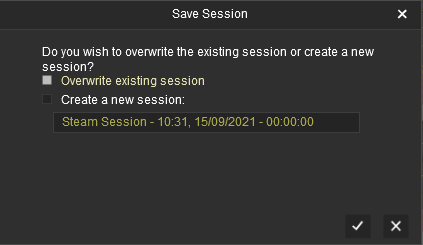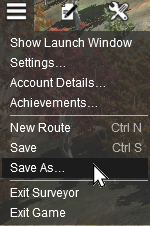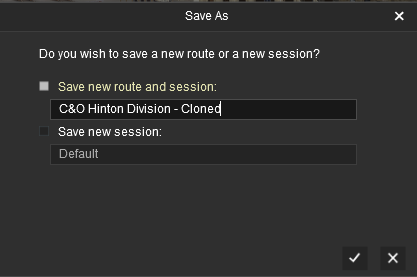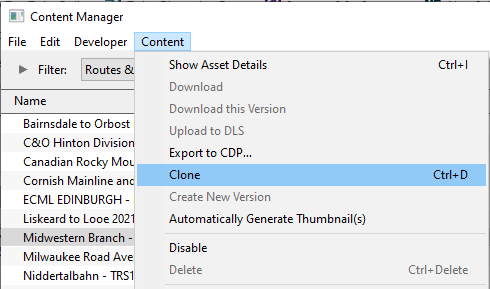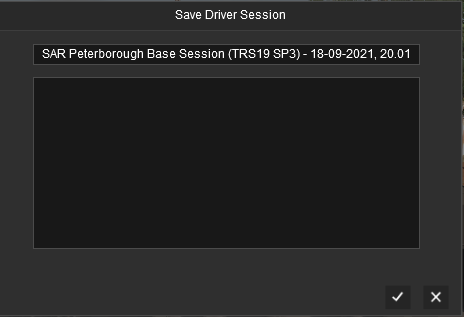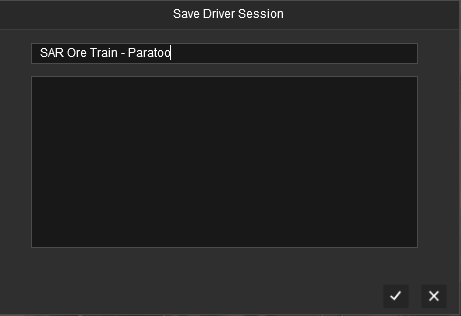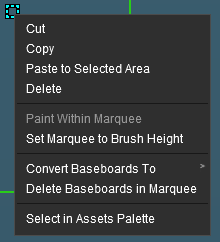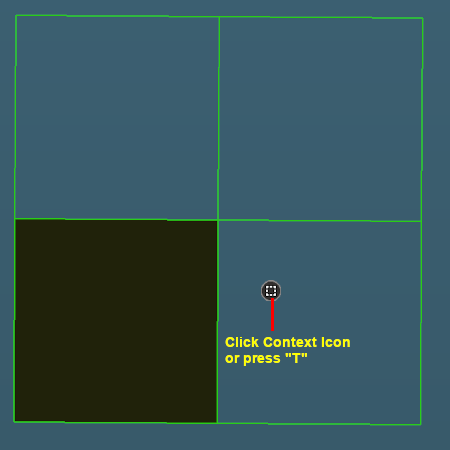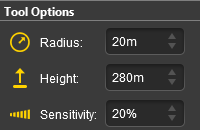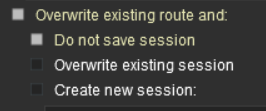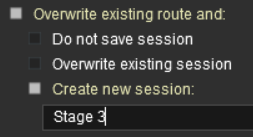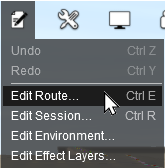| The information in this Wiki Page applies to Trainz Plus, TRS22 and TRS19. This page is intended to provide you with an overview of the properties and features of Routes and Sessions when creating layouts for Trainz. More detailed descriptions of these various features plus instructions on getting you started with creating Routes and Sessions can be found in the Trainz Wiki How To Guides are provided at the end of this document. |
|
|
Workflow Diagrams
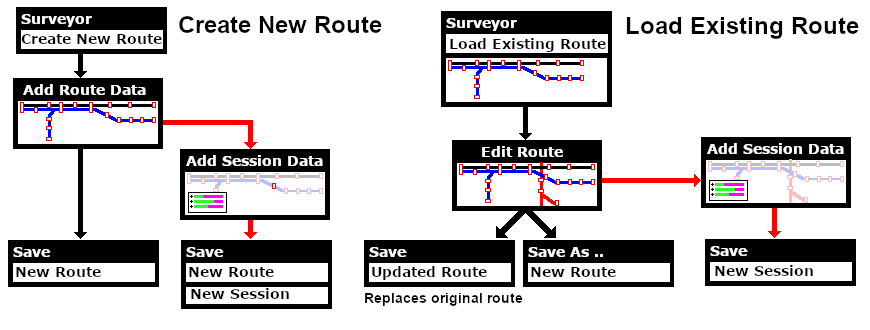
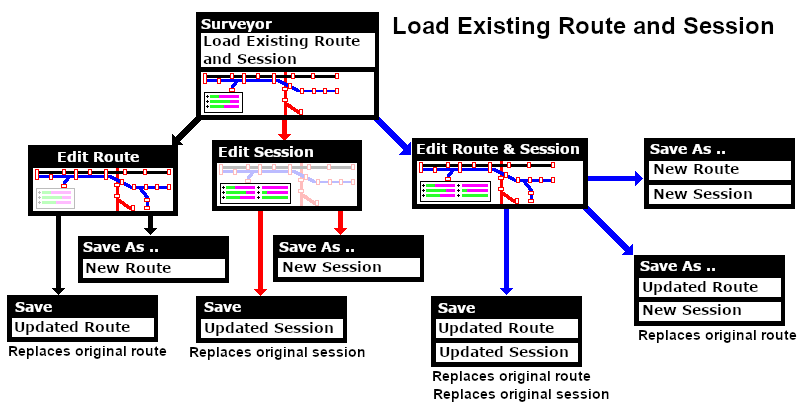 |
| The virtual worlds that Trainz creates can be classified as:- |
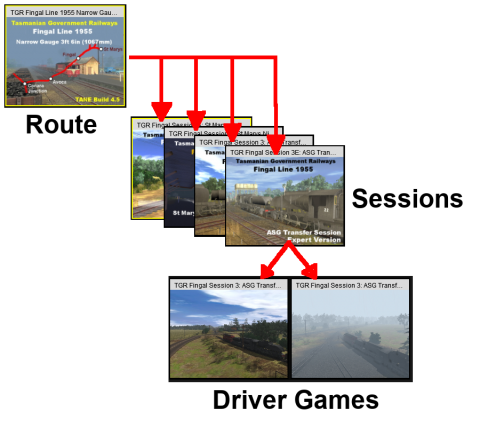 |
 |
Routes |
Routes are created in Surveyor and contain most (if not all) of what you will see in your virtual Trainz world. You can have many different routes, limited only by your storage space. They can be built to represent different geographical regions (real or imagined) and different periods of time (past, present, future). They also control the environment settings in your virtual world, such as your geographic location and altitude, the season of the year, lighting conditions and the weather. Each route can have multiple sessions.
 |
Sessions |
Sessions are also created in Surveyor but are designed to be run in Driver. They contain the instructions that will control your trains when they are operating in automatic or "AI" mode in your route. They also control the goods your trains will carry, load and unload at industries along the way. You can create different sessions for different aspects of your railway - freight, passenger, shunting or a mixture - or for different seasons of the year or times of the day. Sessions are where you can program the behaviour of objects in your virtual Trainz world. A session can also contain scenery items that are specific to a particular railway operation, season or time of day. Sessions also control the environment settings in your virtual world, such as lighting conditions and the weather. Each session can have multiple saved driver games.
 |
Driver Games (or Driver Sessions or Saved Games) |
Driver Games (also known as Driver Sessions and Saved Games) are created in Driver and save the "state of play" in a running session so you can restart it at the same point at a later time. They are optionally stamped with the date and time they were saved and the play duration. |
A route (also known as a "Layout") consists of most of what you will see on the screen when using Surveyor and Driver. Things such as the landform or terrain, most (if not all) of the scenery items, the ground textures, the effect layers (such as TurfFX and Clutter), plus some "environmental" features.
A route consists of two parts:- |
 |
Route Data and |
 |
Route Layers |
|
 |
When you save a Route, all items in the Route Data and Route Layers will be saved |
|
|
 Route Data: Route Data: |
 |
The Route Data stores all those features that are painted into a layout using a brush tool and all the Environmental Data including the World Origin (latitude, longitude, altitude) |
| The Route Data includes the Terrain, Textures, Effect Layers, Legacy Water and the Environmental features. |
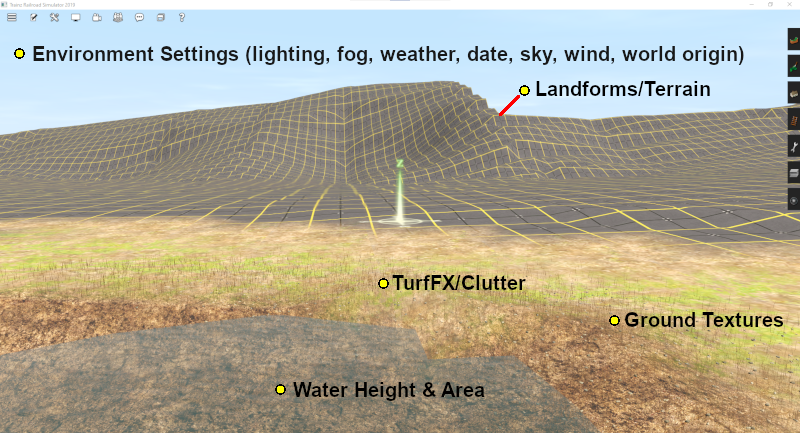
| Route Data contains:- |
 |
Landforms (Terrain) - baseboards and ground height |
 |
Water height and spread for Legacy Water found in Surveyor Classic |
 |
Ground Textures including the grid pattern which is a texture |
 |
TurfFX, Clutter, Water, Color - found in the Effects Layers (the Color Effect Layer is only available in Trainz Plus when using High Definition (HD)) |
 |
Environmental Settings - World Origin (latitude, longitude, altitude), Water Surface (rough/calm/etc), Snow Altitude, Lighting (sun, ambient and water colours), Sky (clouds), Road Traffic (on/off), Date (day, month), Wind strength, Fog level, Weather (rain/fine/snow), Brightness level. You must edit and save the route for these settings to become part of the Route Data - see the Trainz Wiki page  How to Use the Environment Tools for more details. How to Use the Environment Tools for more details. |
|
 Route Layers: Route Layers: |
 |
Route Layers are used to hold the scenery assets that you want to appear in all sessions created for the route |
| All scenery assets are held in layers. Route Layers (you can have many layers) give you a way of organising or grouping the assets displayed in your route. |
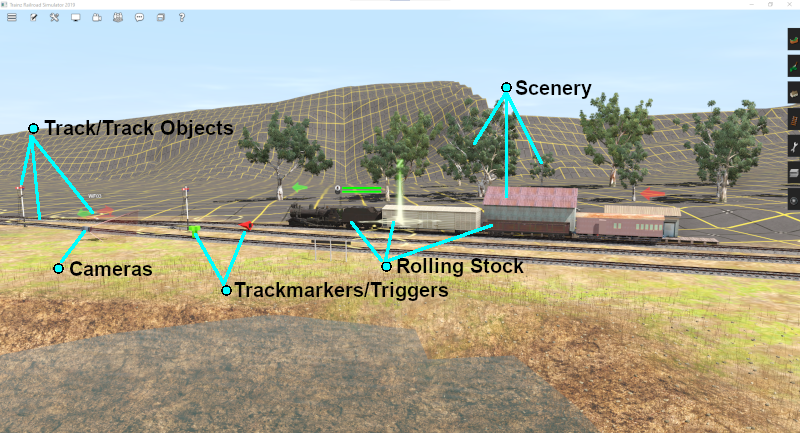
| Route Layers contain:- |
 |
Track and Track Objects (such as signals, switches, bridges, tunnels, speed signs, etc) |
 |
Most (or all) scenery items (e.g. buildings, trees, rocks, active industries/stations) and scenery splines (e.g. roads, fences, etc) |
 |
Rolling Stock (including locos) - Note: It is strongly recommended that all rolling stock be placed into a Session Layer |
 |
Lineside and Fixed Cameras |
 |
Trackmarks, Triggers, Direction and Priority Marks |
|
 |
Scenery objects can also be stored in a session. This can cause confusion if you load a route without loading a session and find that some scenery items are "missing". See  Loading an Existing Route below for how to deal with this situation. Loading an Existing Route below for how to deal with this situation. |
|
 |
A detailed description of Layers can be found on the Trainz Wiki Page:-
|
Loading (and Creating) a Route
|
 |
|
 |
 |
 |
 |
 |
A Left Click on the MAIN MENU button (bottom left) will take you back to the starting or main screen. |
 |
A Left Click on the Sort By A-Z button (top near right) will give you a drop down menu of sorting options for the thumbnail list. |
 |
A Left Click on the Expand View  button (top right) will expand the thumbnail list to fill the screen - Left Click it again to return the thumbnails to the strip at the bottom of the screen. button (top right) will expand the thumbnail list to fill the screen - Left Click it again to return the thumbnails to the strip at the bottom of the screen. |
|
| The thumbnail images are colour coded. |
| Payware on DLC |
Must be purchased and downloaded, but some may be free - depending on your membership options. If you click a thumbnail with this colour a DOWNLOAD button will appear on the bottom right of the screen. If a price is included in the button then that is the purchase price (in $US) |
| Payware installed |
Already installed from the DLC. DLC items cannot be deleted. To remove them use the Uninstall option in the Content Store from the Launcher. You can reinstall them later without any additional cost |
| Installed |
Downloaded from the Download Station (DLS) or created by you. This includes any cloned DLC Routes and Sessions (see  Cloning a Route/Session below) Cloning a Route/Session below) |
| Multiplayer |
For simultaneous development by multiple players. Special conditions apply |
Creating a New Route
|
 |
 |
|
|
|
|
 |
When you create a new Route a new default Session will also be created for it. Sessions contain specific data that are not found in routes. See  What is a Session? below. What is a Session? below.
When you save the new route you will be given the opportunity to save the session as well. If you have not added anything to the session then saving it is optional. |
|

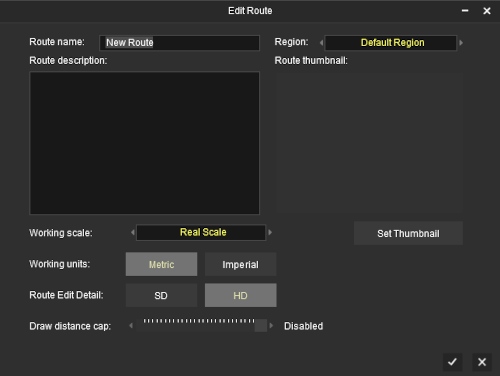 |
You can easily edit the route settings at any time after the route has been created.
| Steps: To edit the route details at any time:- |
 |
Open the  Edit menu from the top menu in Surveyor and select the Edit Route... option Edit menu from the top menu in Surveyor and select the Edit Route... option
The keyboard shortcut is Ctrl + E |
|
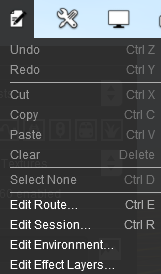 |
|
|
|
|
It is recommended that you enter some details before you click the  icon to create the new route. A bare minimum is listed on the right that will save you some time and effort later, and you can always change them at any time. icon to create the new route. A bare minimum is listed on the right that will save you some time and effort later, and you can always change them at any time. |
|
| Route name: |
Enter a name for your new Route (keep it simple but descriptive)
|
| Geographical region: |
Select a region from the drop down list |
|
|
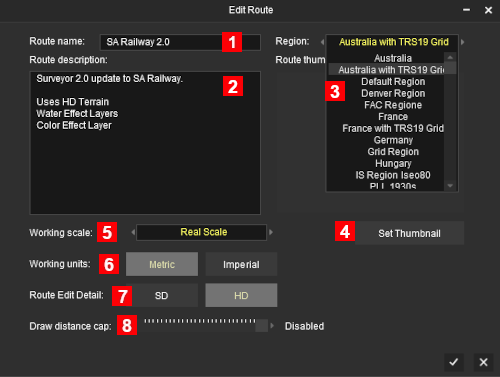
A Left Click on the  icon at the bottom right of the window will apply the new data settings to the single flat baseboard that you have just created. icon at the bottom right of the window will apply the new data settings to the single flat baseboard that you have just created.
A Left Click on the  icon at the bottom right of the window will cancel the data entry and continue to use the default data settings (usually the settings entered for the last route you created) in the single flat baseboard currently on the screen. icon at the bottom right of the window will cancel the data entry and continue to use the default data settings (usually the settings entered for the last route you created) in the single flat baseboard currently on the screen.
 |
Notes: Baseboard Texture
|
When a baseboard is added it will be covered with the Default Ground Texture which is usually the last one that you used. Selecting a Region (Point 3 in the Notes: Route Options on the right) will set the ground texture to be used in every baseboard added to the new route. Some regions have a standard grid pattern as their default ground texture - look on the DLS for region assets with TRS19 Grid in their titles. You can change the selected Region and its ground texture as often as you like but this will also change other properties of the route as described on the right.
You can create your own Region with your preferred ground texture and other features - see the Trainz Wiki Page  How to Create a Region Asset for the details How to Create a Region Asset for the details |
|
|
 |
Notes: Route Options
|
 |
Enter a Route name for the route - keep it simple but as descriptive as possible (without writing an essay). This will be the first thing that users will see when looking for a route to download from the DLS. |
 |
Enter a Route description for the route. At the starting stage this is basically a "memory jogger" for you so a basic description would be sufficient but before you release the finished route (e.g. to the DLS) it should contain some critical information such as Trainz Plus only, "high detail assets used" and the source(s) of any non-DLS dependencies |
 |
Setting a Region sets some basic features of the route - such as its latitude (used to determine the season of the year), the altitude (in metres) of the first baseboard, the number and types of moving road vehicles (if any) and the side of the road they drive on, to name a few. If none of the installed regions are suitable you can download others from the DLS or create a region of your own - see the Trainz Wiki Page  How to Create a Region Asset How to Create a Region Asset |
 |
Create a Route thumbnail image. At the starting stage this is less important but at some point, before the route is released, select a suitable camera view point and Left Click on the Set Thumbnail button. The thumbnail is an advertisement for the route and many potential users will judge the quality of your work by the thumbnail when deciding whether to download or not |
 |
The Working scale provides measurements that are comparable to model railroading dimensions, but the actual (physical) sizes of the layout and its assets are not altered or scaled down. It is only the Surveyor Ruler and its measurements that will be affected. The choices are between Real scale (which is the default), G scale (100m real scale = 4.4m G scale), HO scale (100m real scale = 1.1m HO scale) and many other options. |
 |
The Working units provides a choice between Metric (metres, kilometres) and Imperial (yards, miles) which only affects measurements used by rulers (in Surveyor 2.0 separate metric and imperial rulers are available), track distances and train speeds (km/h or mph).
Note that track speed signs are always locked at either metric (km/h) or imperial (mph) - there are separate speed signs available for each. The signs will not be altered by this selection but their values will be converted. So a track speed sign that is set at 40 mph, for example, will still be displayed as 40 but it will be read as 64.3 km/h in Driver if the Working Units have been set to metric. So it will be less confusing if you use speed signs that are in the same working units as your route, for example use a metric sign showing 65 km/h instead of an imperial sign showing 40 mph.
Altitudes are always measured and displayed using metric units (metres). |
 |
The Route Edit Detail in Trainz Plus only. This sets the minimum ground brush size when working with HD resolution. It can be swapped between the two settings at anytime when editing. See SD/HD Options below for more details |
 |
The Draw distance cap sets how far away from the camera that scenery objects will be drawn. A high setting, particularly the Disabled option (which means no draw distance cap), could affect the game performance, including the fps rate (frames per second), on some systems |
|
|
The Surveyor World View
|
 |
 |
|
|
|
|
Depending on the Route Editor settings and the version of Trainz you are using, you may see or be affected by the following factors:-
Baseboards and Grid Squares: |
 |
Each Baseboard is always 720m x 720m (2362.2ft x 2362.2ft) regardless of the Working scale and Working units you have selected |
 |
Baseboards without any applied ground texture will be covered with grid squares. Each yellow Grid Square is always 10m x 10m (32.8ft x 32.8ft) regardless of the Working scale and Working units you have selected |
| But in both cases the distance measurement shown by a ruler object will depend on the Working scale and Working units selected |
| Grid Resolution: See Notes: above |
 |
10m resolution - the default setting for new baseboards created using TRS19 and TRS22 OR |
 |
5m resolution - at 4x the resolution of 10m. You can have a mixture of 10m and 5m resolution baseboards in the same route OR |
 |
HD (High Definition) resolution - at 6400x the resolution of 10m and 1600x the resoltion of 5m this resolution is only available in Trainz Plus. It is the default setting for new baseboards created using Trainz Plus and it is NOT recommended that HD baseboards be mixed with 10m/5m baseboards in the same route |
| Baseboards can be converted between these resolution settings at any time |
| Baseboard Altitude: |
 |
The altitude (in metres) of the first baseboard will depend on the Geographic region you have selected but the default value is 0m |
| Baseboard Texture: |
 |
The baseboard will be covered with a texture, such as grass or a grid pattern. This is set by the Geographic region and the selection made in the Ground option from the  Surveyor Display Menu - see Surveyor Display Menu - see  Default Baseboard Ground Texture below Default Baseboard Ground Texture below |
|
In Surveyor Classic (S10)
Surveyor Classic or S10 is the version of Surveyor found in TRS19, TRS19PE and TRS22. It is one of two versions of Surveyor available in TRS22PE and Trainz Plus.
In Surveyor Classic the baseboards are controlled using the Topology Tools. To open the tools fly-out either Left Click the Topology Tool Tab or press the F1 key.
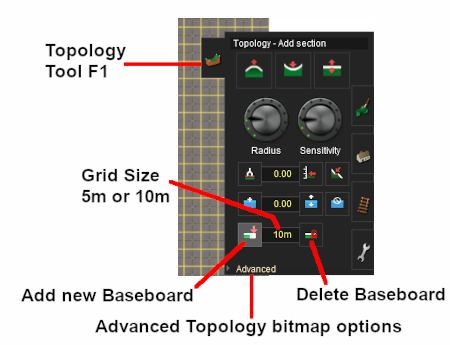
|
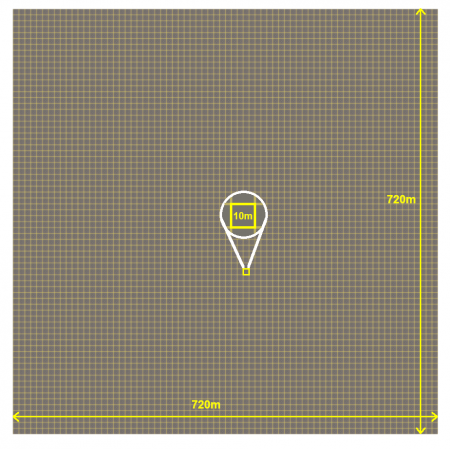 |
| |
The Key Topology Tools, as shown in the diagram above, are:- |
 |
Add New Baseboard - Left Click (it will stay active until another button is clicked) and then Left Click in a blank area outside the baseboard to add a new baseboard in that position. Each click will add a new baseboard at the same altitude as the first |
 |
Delete Baseboard - Left Click (it will stay active until another button is clicked) and then Left Click anywhere on a baseboard to delete that baseboard. You will get a warning dialogue window - you CANNOT undo this operation to restore a deleted baseboard |
 |
Grid Resolution - a pop-out menu will give you a choice of 10m (the default) or 5m. The option for the HD resolution is only available in Trainz Plus. This sets the resolution of the baseboard. It does not alter the size of the grid squares which is actually a painted texture and will always stay at 10m x 10m.
 |
With a 10m resolution the smallest area in which you can set a height is 10m x 10m |
 |
With a 5m resolution that becomes 5m x 5m, so 4 different height values can be set in each 10m grid. This allows you to create more accurate topology features such as railway cuttings and embankments but it has a penalty, significantly larger route map files |
 |
With HD resolution (in Trainz Plus only) the smallest area (resolution) in which you can set a height is 0.125m x 0.125m. This allows you to create even more accurate topology features but it has a penalty, enormously larger route sizes - on average 5x or more larger than 10m resolution maps |
 |
Each new baseboard you add will have its resolution set to the selected value. You can have different baseboards set to each resolution - for example: baseboards used by the track set at 5m and those further out at 10m
This control is also used to change an existing baseboard from one resolution to the other. |
|
 |
Advanced - this will open another window in the Topology Tab that will allow you to select a grey scale bit map image to set the height of each grid |
In Surveyor 2.0 (S20)
Surveyor 2.0 or S20 is an alternative version of Surveyor found in TRS22PE and Trainz Plus. Surveyor Classic is also available as an option in both TRS22PE and Trainz Plus.
In Surveyor 2.0 there is no separate Topology Tools fly-out. A single Tools Palette replaces all the separate tools "fly-outs" found in the original Surveyor Classic. |
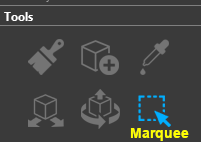 |
| Steps: To add new baseboards:- |
 |
select the  Marquee Tool from the Tools Palette (or press the F key). Marquee Tool from the Tools Palette (or press the F key). |
| Note that in S20 you can add and delete multiple baseboards in a single step, not just one-at-a-time. |
 |
Left Click and Drag (using the Left mouse button) to draw out an area where the new baseboards will be added. This area can include the current baseboard. |
|
| The Marquee area, shown with a green border in the image below right, shows the positions where 3 new baseboards will be created to add to the existing baseboard. The Marquee area has a Context Menu icon as shown in the image. |
 |
Left Click on the Context Menu icon or press the T key to open up the Marquee Context Menu.
|
| The main Marquee Baseboard Operations, as shown in the Marquee Context Menu above, are:- |
|
|
|
Default Baseboard Ground Texture
|
 |
 |
|
|
|
|
| When a new route is created or a new baseboard is added in both Surveyor Classic and Surveyor 2.0 it will be covered with the ground texture for the selected Region or the default texture/grid if no region has been set. This can be changed to a different texture (including to the standard TRS19/TRS22 grid pattern). |
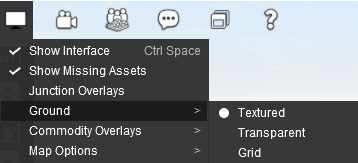 |
| Steps: To disable the current default ground texture (easiest method):- |
 |
open the  Surveyor Display Menu Surveyor Display Menu |
 |
select the Ground option |
 |
select the Grid sub-option. This will use the current grid texture. |
|
|
| A more complex solution is to edit an existing Region or create one of your own to add your preferred ground texture (such as the standard TRS22 grid pattern) to each new route you create and every new baseboard that you add. |
 |
Notes:
The Baseboard Ground Texture, chosen from the Surveyor Display Menu or by specifying a Region, will become the default for every new route you create and every new baseboard you add, until you change it to something else.
|
|
 |
Information on creating and editing Region assets can be found on the Trainz Wiki at:-
|
Loading an Existing Route
|
 |
 |
|
|
|
|
 |
When you load an existing Route without also loading a Session, a new default Session will be created for it. Sessions contain specific data that are not found in routes. See  What is a Session? below. What is a Session? below.
When you save the route you will be given the opportunity to save the new default session as well. If you have not added anything to the session then saving it is optional. |
|
| You must first find and select the route to load from those already installed. At the top of the Driver/Surveyor screen the route search options are shown as a set of buttons. |

| Type: |
ROUTES is the default selection. No need to change this. |
| Source: |
PURCHASED is the default selection, Click and change to MY CONTENT for a route you have created (or already modified) or to INSTALLED for one you have downloaded from the DLS. |
| Region: |
ALL is the default selection. You can select a particular geographic region if required and IF the route had a geographic region set when it was created. |
| Search: |
You can narrow down the list of routes by typing the first few letters of its name (e.g. SA) as shown in the image above. |
| This will produce a display of thumbnails at the bottom of the screen. |

| Left Click on the thumbnail for the route you want to load, then Left Click on the EDIT ROUTE button to load the route into Surveyor. |

 |
Notes: Routes and Sessions - An Endless Source of Confusion
 |
Scenery objects that have been placed in a session will NOT APPEAR if the route has been loaded into Surveyor without also loading the session |
 |
If scenery objects have mysteriously vanished when you reload a route into Surveyor it is highly likely that those objects have been saved in a session. You must load the session into Surveyor to make them visible again |
 |
You can easily move most scenery objects from a session into a route if needed - see the Trainz Wiki Page  How to Use the Bulk Asset Update/Replace Tool for more details How to Use the Bulk Asset Update/Replace Tool for more details |
|
|
Loading a Route Into Surveyor From Content Manager
|
 |
 |
|
|
|
|
| Trainz provides a shortcut that allows you to load an existing route directly into Surveyor for editing from Content Manager. |
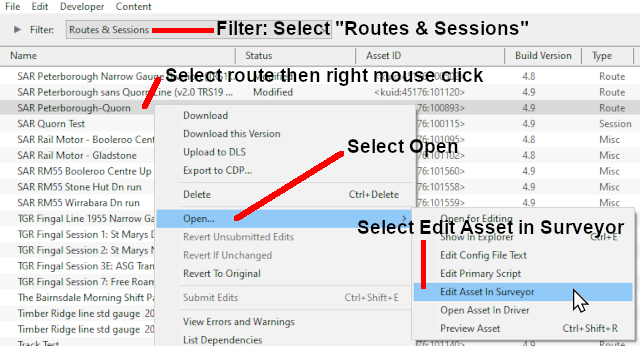 |
Steps: To load a route from Content Manager:-
 |
in Content Manager select the filter Routes & Sessions |
 |
select the route to be edited |
 |
Right Click to open the Command Menu |
 |
select Open..., then select Edit Asset in Surveyor
|
|
|
|
Loading After an Unexpected Shutdown
|
 |
 |
|
|
|
|
| The options you will see are:- |
| Use changes |
Use the edited/changed versions that are in the open database assets. Note: there is a possibility that these assets may have been damaged during the shutdown and may be corrupted |
| Revert changes |
Ignore the edited/changed versions and load the previous versions instead |
| Cancel |
Cancel the Load and return to the Surveyor/Driver menu screen |
| You could also use the Content Manager program (select Manage Content from the Trainz Launcher) to Submit the open route or route and session assets. This has the risk of replacing the last good copy of that asset or assets with a possibly faulty copy. |
|
Editing a Route
|
 |
 |
|
|
|
|
 |
When a Route is loaded or a new Route is created all the assets you add will be automatically placed into a Route Layer |
When you create a new route, or load an existing route without a session, and start adding scenery assets they will automatically be placed into a Route Layer. See  How to Use Layers for more details. How to Use Layers for more details.
Any ground textures, effect layers (e.g. TurfFX, Water, Clutter) you add, or terrain changes (including new baseboards) you make, will be added to the Route Data. |
 |
WARNING: Do not edit track in a Route that is occupied by consists in any of the Sessions based on the Route
Moving or deleting a section of track in a Route that is occupied by a consist in a Session can cause the consist to become a "missing asset". This can happen if you load the Route only and not the Session. If a consist becomes a "missing asset" then the only immediate solution is to use the Delete missing assets command from the Tools menu in Surveyor.
Prevention:
if you have the consists placed in a Session then always load the Session, not just the Route, and move or delete any consists BEFORE editing the track they are occupying.
|
|
 |
You can edit the Route Characteristics at any time by selecting the Edit Route... option from the  Edit Menu OR simply by pressing the Ctrl + E keys. Edit Menu OR simply by pressing the Ctrl + E keys.
This will bring up the Edit Route dialogue window (shown below). |
|
|
 |
Route Characteristics:-
 |
Name and Description |
 |
assigned Geographic Region, which sets a number of different features |
 |
Thumbnail image |
 |
Working Scale and Working Units |
 |
Draw Distance |
|
|
|
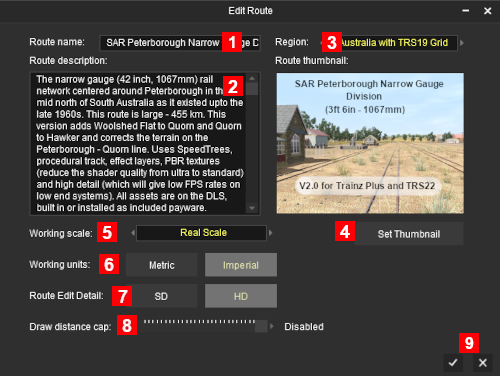 |
 |
Route name . Editing this will change the route username in the config.txt file but it will not alter the route <kuid> value |
 |
Route description . Edit to include additional information or describe changes that have been made |
 |
Region . Changing the region (the Geographic region) selected could affect other features such as the moving road traffic, season of the year (through the latitude tag) and altitude |
 |
Route thumbnail . Left Click on the Set Thumbnail button to take a snapshot using the current camera view which will be used as the new thumbnail. The image shown in the example on the left has been edited. |
 |
Working scale . Changing this will only affect the measurement shown in the Surveyor Ruler tool |
 |
Working units . Switching between Metric and Imperial will change how train speeds are calculated and displayed in Driver (in km/h or mph) and the units used by track speed signs |
 |
Route Edit Detail in Trainz Plus only. This sets the minimum ground brush size when working with HD resolution. It can be swapped between the two settings at anytime when editing. See SD/HD Options below for more details |
|
 |
Draw distance cap will affect how far away from the camera that scenery objects will be drawn. A high setting, particularly the Disabled option (which means no draw distance cap), could affect the game performance, including the fps rate (frames per second), on some systems |
 |
Left Click on the  icon to save the entered values and exit back to Surveyor. Left Click on the icon to save the entered values and exit back to Surveyor. Left Click on the  icon to cancel any entered values and exit back to Surveyor icon to cancel any entered values and exit back to Surveyor |
|
| SD/HD Options |
 |
| The Surveyor Route Editor will allow you to switch between two minimum brush sizes when working with HD resolution routes. |
| This option, available in Trainz Plus only, allows you to set the brush detail to the default HD (High Definition) or to a lower SD (Standard Definition) which is easier to work with over larger areas.
|
Adding Terrain Height, Textures, Effect Layers in a Route
|
 |
 |
|
|
|
|
 |
Terrain, Textures, Effect Layers can only be added to a route not a session |
 |
The height of the terrain can be adjusted to represent hills, valleys, plains, slopes |
 |
The Terrain can be painted with textures to represent real ground surfaces |
 |
Effect Layers (grasses, rocks, water, etc) can be added to the terrain to enhance its appearence. The types of effect layers that are available will depend on your Trainz version, GPU and Operating System |
 |
 |
The Ground Height and Ground Texture are kept in special layers that cannot be renamed, moved, deleted or merged with other layers |
 |
The Effect Layers (TurfFX, Clutter, Water and Color) are found:-
 |
in the Advanced Topology Tools (press the F1 key and open the Advanced tab) in Surveyor Classic |
 |
as layers in the Layers Palette in Surveyor 2.0 |
They can be deleted and renamed but cannot be moved or merged with other layers |
|
|
|
In Surveyor Classic (S10)
| In Surveyor Classic (S10) the tools and objects are in tabbed icons on the right of the screen which can be opened by a Left Click on the icon or by pressing its Function Key |
 |
F1 |
The Terrain Height, Legacy Water and Effect Layers are added and manipulated by tools in the Topology icon (the F1 key). For the Effect Layers you will also need to open the Advanced tab |
 |
F2 |
The Ground Texture is added and manipulated by tools in the Paint icon (the F2 key) |
| Opening each tool will reveal a selection list of assets and/or a set of tools for applying and manipulating the selected feature |
|
In Surveyor 2.0 (S20)
| In Surveyor 2.0 (S20) there is a single set of common tools that can add and manipulate objects of any type. Select a tool by a Left Click on its icon in the Tools Palette or by pressing its key. You can also select multiple objects, that can be of different types, and manipulate them (move, rotate, delete) as if they were a single object. |
 |
W |
The Brush Tool in the Tools Palette sets the Terrain Height, paints the Ground Textures and adds/edits Effect Layers (including Water). The textures and effect layers are selected using the Filter Palette and the Assets Palette |
There is a Wiki Page that covers in great detail the use of the Surveyor 2.0 tools at  How to Use S20 Tools with specific sections dealing with Ground Height, Ground Terrain and Effect Layers How to Use S20 Tools with specific sections dealing with Ground Height, Ground Terrain and Effect Layers |
|
 |
Effect Layers |
| The Effect Layers are TurfFX (grasses, bushes, crops, etc), Clutter (small ground cover such as grasses and stones), Water and Color |
 |
The TurfFX Effect Layer is only available if you have an NVidia Graphics Card (e.g. a GTX or RTX) and Windows OS (Windows 10 or 11) |
 |
The Color Effect Layer is only available in Trainz Plus when using the High Definition (HD) mode |
|
|
Adding Assets to a Route
|
 |
 |
|
|
|
|
 |
Assets include all visible objects (trees, buildings, roads, tracks, signals, rolling stock, etc) and invisible objects (track triggers, track marks, etc) that can be added to your route |
 |
Objects added to your route will be present in all sessions created using that route |
In Surveyor Classic (S10)
| In Surveyor Classic (S10) the tools and objects are in tabbed icons on the right of the screen which can be opened by a Left Click on the icon or by pressing its Function Key. |
 |
F3 |
Scenery objects (e.g. buildings) and splines (e.g. roads) are added and manipulated by tools in the Objects icon (the F3 key) |
 |
F4 |
Railroad tracks and track objects (e.g. signals, switches, etc) are added and manipulated by tools in the Tracks icon (the F4 key) |
 |
F7 |
Rolling stock (locomotives, wagons) are added and manipulated by tools in the Trains icon (the F7 key) |
| Opening each tool will reveal a selection list of assets and a set of tools for applying and manipulating the selected asset |
|
In Surveyor 2.0 (S20)
| In Surveyor 2.0 (S20) there is a single set of common tools that can add and manipulate objects of any type. Select a tool by a Left Click on its icon in the Tools Palette or by pressing its key. You can also select multiple objects, that can be of different types, and manipulate them (move, rotate, delete) as if they were a single object. |
 |
E |
The Placement Tool adds ALL objects (scenery, splines, track and track objects, rolling stock) selected using the Filter Palette and the Assets Palette |
 |
S |
The Free Move Tool moves ALL objects, either individually or as a group, to anywhere on the surface |
 |
D |
The Fine Adjustment Tool moves and rotates ALL objects, either individually or as a group, in small movements to anywhere on, below or above the surface |
There is a Wiki Page that covers in great detail the use of the Surveyor 2.0 tools at  How to Use S20 Tools How to Use S20 Tools |
|
Editing the Environment of a Route
|
 |
 |
|
|
|
|
Edit Effect Layers
|
 |
 |
|
|
|
|
 |
The Edit Effect Layers menu option allows you to add, remove and edit the special effect layers |
| Effect Layers contain:- |
 |
TurfFX - 3D animated grasses including crops (e.g. wheat) |
 |
Clutter - rocks, stones, small clumps of plants (grasses, flowers, etc) |
 |
Water - a layer of water that covers the entire route but its height can be set to different values to be hidden or revealed throughout the route. It is possible to set a slope on the water (perfect for a water skiing scene 😀) |
 |
Color - a transparent "skin" that covers the ground texture throughout the entire route. Different parts of this layer can be given different colors or "tints" to alter the appearance of the texture below. This is only available for Trainz Plus subscribers when using HD terrain |
| You can have multiple effect layers of each type (except the color layer) in a route. |
|
|
 |
Notes:
|
 |
Currently, there are differences in the Effect Layers between Windows and MacOS versions of Trainz. Some of these differences are hardware (GPU) dependant. This means that some of the effect layers or features will not work on the MacOS platform. |
 |
TurfFX is hardware dependent and requires an Nvidia graphics card. TurfFX is an Nvidia software product and is not from N3V. |
 |
The latest versions of Trainz are starting to eliminate these differences and, for performance improvements, are moving the implementation of some effect layers from the CPU to the GPU. |
|
|
Merging Routes
 |
Two (or more) separate routes can be joined together (merged) to create a new route |
| There are some important restrictions on the merging of two routes:- |
 |
Payware (DLC) routes cannot be merged with Freeware (DLS) or other Payware routes |
 |
The Session Data and Session Layers in the first route can be saved in the merger (if required) but those in the other route cannot |
 |
There may be a significant height difference between the two routes and this may not be easy to overcome |
 |
The orientation of the two routes (East-West or North-South) cannot be changed (it is possible but will usually require a lot of time, effort and patience) |
 |
A detailed description of the process of Merging Routes can be found on the Trainz Wiki Page:-
|
 |
A Session is always a part of an existing Route - you cannot have a Session that does not belong to a Route |
 |
If you create a Route without a Session then ALL the active industries and rolling stock, time, environmental conditions, etc, will revert to their original (default) values. There will be no AI drivers and drivers will have a very limited set of available commands for manual driving |
In general, while a route provides the physical structures (or "hardware"), a session provides the services (or "software"). While you can easily have a route without a session, it could be a very limited (or even a boring) experience.
A single route can have multiple sessions, or none, but a session must always belong to a route. To put it into Trainz terminology, a session has a route as a dependency.
A session consists of two parts:-
|
 |
Session Data and |
 |
Session Layers |
|
 |
When you save a Session, all items in the Session Data and Session Layers will be saved |
|
|
 Session Data:
Session Data:
| Session Data are often the "invisibles" that control the operation of a session. Session rules, driver orders and loco assignments, commodities (loaded, unloaded and carried) and most of the Environmental Settings are examples of Session Data. |
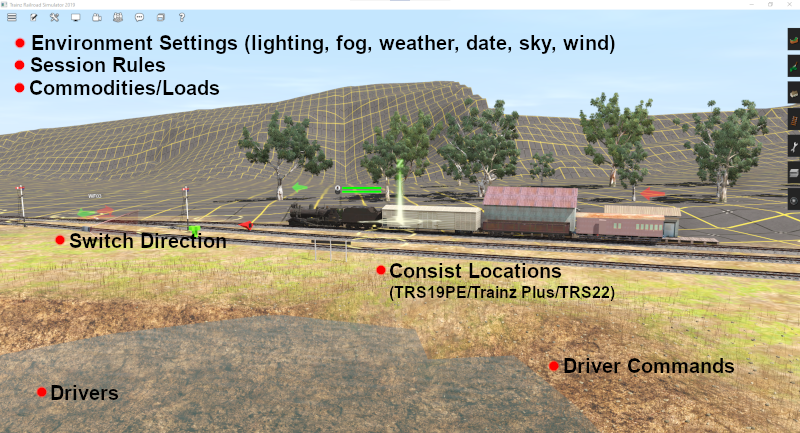
| Session Data contains:- |
 |
Drivers (names, AI commands and assigned locos) |
 |
Driver Commands - those available for AI and manual driving |
 |
Session Rules |
 |
Industry Settings (commodities consumed and produced) |
 |
Consist Settings (commodities carried) |
 |
Consist Locations - this is stored in the session even if the consists are placed in the route |
 |
Switch Settings (left/right) - but the default switch direction is stored in the route. See  Setting Switch Directions in Routes and Sessions for more information on this Setting Switch Directions in Routes and Sessions for more information on this |
 |
Environmental Settings - Water Surface (rough/calm/etc), Snow Altitude, Lighting (sun, ambient and water colours), Sky (clouds), Road Traffic (on/off), Date (day, month), Wind strength, Fog level, Weather (rain/fine/snow), Brightness level. You must edit and save the session for these settings to become part of the Session Data - see  How to Use Environment Tools for more details. If both a route and a session have saved Environmental Settings, which do not have to be the same, then those in the session will be used. If the session does not have any saved Environmental Settings then those in the route will be used How to Use Environment Tools for more details. If both a route and a session have saved Environmental Settings, which do not have to be the same, then those in the session will be used. If the session does not have any saved Environmental Settings then those in the route will be used
|
|
 Session Layers:
Session Layers:
 |
Session Layers are used to hold the scenery assets that you want to only appear in that particular Session and not in all Sessions. The Session Layers can be left empty and the Route Layers can contain all the scenery assets |
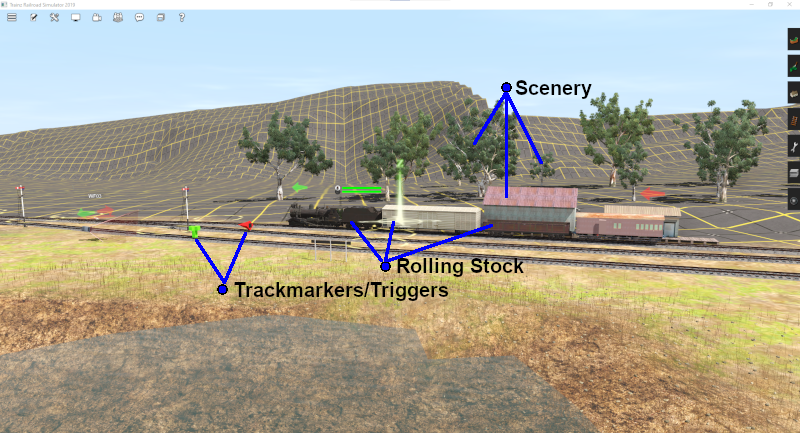
Session Layers give you a way of organising or grouping the assets displayed in your session.
| Session Layers can contain any assets that will be unique to that Session:- |
 |
Scenery |
 |
Rolling Stock (including locos) - Note: It is strongly recommended that all rolling stock be placed into a Session Layer |
 |
Trackmarks, Triggers, Direction and Priority Markers |
|
|
|
 |
WARNING:
While it is possible to add track and track objects (bridges, tunnels, turntables, signals, switches, etc) to Session Layers it is NOT RECOMMENDED. These assets should always be placed into Route Layers Group and, preferably, into the route-layer itself. |
|
|
 |
A detailed description of Layers can be found on the Trainz Wiki Page:-
|
Loading (and Creating) a Session
|
 |
|
 |
 |
 |
 |
Creating a New Session
 |
To create a new Session you must first create a new Route or load an existing Route |
 |
A route can have many individual sessions so a new session can be added to a route that already has sessions |
|
| Steps: To add a new session to an existing route:- |
 |
Locate (but do not load) the route as described in the section  Loading an Existing Route above Loading an Existing Route above |
 |
Once you have selected the route from its thumbnail, Left Click on the VIEW SESSIONS button
 |
 |
Then Left Click on the CREATE SESSION button. If no other session exists for this route then this will be the only choice available to you
 |
|
Loading an Existing Session
|
 |
 |
|
|
|
|
There are two different ways to load existing sessions into Surveyor.
 |
Select the Route First |
|
|
 |
If the EDIT SESSION option is not present then the selected session is a saved Driver Game (a "game" saved when in Driver) and cannot be edited. See the section  Saving and Loading Sessions in Driver below. Saving and Loading Sessions in Driver below.
|
|
|
|
Both  and and  will load the route and session into Surveyor. will load the route and session into Surveyor. |
Loading a Session Into Surveyor From Content Manager
|
 |
 |
|
|
|
|
Trainz provides a shortcut that allows you to load an existing session directly into Surveyor for editing from Content Manager.
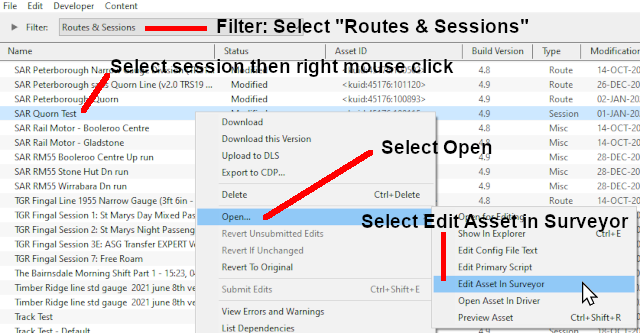 |
Steps: To load a session into Surveyor:-
 |
in Content Manager select the filter Routes & Sessions |
 |
select the session to be loaded and edited in Surveyor |
 |
Right Click to open the Command Menu |
 |
select Open... , then select Edit Asset in Surveyor |
Both the route and the session will be loaded into Surveyor for editing. |
|
|
Loading a Session into Driver From Surveyor
|
 |
 |
|
|
|
|
To start Driver simply select a session as described above in Loading an Existing Session and Left Click on the DRIVE SESSION button.

This will load both the session and the route into Driver.
You can save your "game play" in Driver at anytime. See  Saving and Loading Sessions in Driver below.
Saving and Loading Sessions in Driver below.
Loading a Session into Driver From Content Manager
|
 |
 |
|
|
|
|
Trainz provides a shortcut that allows you to load an existing session directly into Driver from Content Manager.
Editing a Session
|
 |
 |
|
|
|
|
 |
WARNING:
When a Session is loaded into Surveyor or a new Session is created all the assets you add will be AUTOMATICALLY placed into a Session Layer. To place them in a different layer, for example a Route Layer, change the Active Layer to the required layer before adding them to the route. See the Trainz Wiki Page  How to Use Layers for more details. How to Use Layers for more details. |
|
Any changes made to the Session Rules (including drivers and their commands), the Environment Tools, Industry or Rolling Stock settings, will be added to the Session Data.
There are other changes that will also be added to the Session Data. |
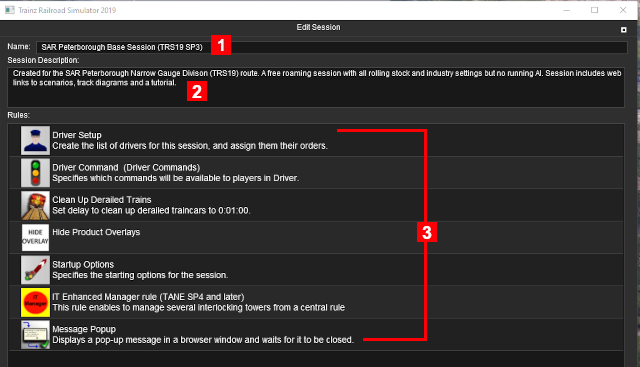 |
|
 |
You can edit the Name of the Session. This will change the session username in the config.txt file but it will not alter the session <kuid> value |
 |
You can edit the Session Description |
 |
You can add, delete and edit the Session Rules |
|
Adding Assets to a Session
|
 |
 |
|
|
|
|
 |
Assets include all visible objects (trees, buildings, roads, tracks, signals, rolling stock, etc) and invisible objects (track triggers, track marks, etc) that can be added to your session |
 |
Any objects added to a session will only be available in that session |
In Surveyor Classic (S10)
| In Surveyor Classic (S10) the tools and objects are in tabbed icons on the right of the screen which can be opened by a Left Click on the icon or by pressing its Function Key |
 |
F3 |
Scenery objects (e.g. buildings) and splines (e.g. roads) are added and manipulated by tools in the Objects icon (the F3 key) |
 |
F4 |
Railroad tracks and track objects (e.g. signals, switches, etc) are added and manipulated by tools in the Tracks icon (the F4 key) |
 |
F7 |
Rolling stock (locomotives, wagons) are added and manipulated by tools in the Trains icon (the F7 key) |
| Opening each tool will reveal a selection list of assets and a set of tools for applying and manipulating the selected asset |
|
In Surveyor 2.0 (S20)
| In Surveyor 2.0 (S20) there is a single set of common tools that can add and manipulate objects of any type. Select a tool by a Left Click on its icon in the Tools Palette or by pressing its key. You can also select multiple objects, that can be of different types, and manipulate them (move, rotate, delete) as if they were a single object. |
 |
E |
The Placement Tool adds ALL objects (scenery, splines, track and track objects, rolling stock) selected using the Filter Palette and the Assets Palette |
 |
S |
The Free Move Tool moves ALL objects, either individually or as a group, to anywhere on the surface |
 |
D |
The Fine Adjustment Tool moves and rotates ALL objects, either individually or as a group, in small movements to anywhere on, below or above the surface |
There is a Wiki Page that covers in great detail the use of the Surveyor 2.0 tools at  How to Use S20 Tools How to Use S20 Tools |
|
Editing the Environment of a Session
|
 |
 |
|
|
|
|
 |
Environmental settings in a Session will have priotity over those in a Route |
Saving a Route and a Session
|
 |
 |
 |
 |
 |
 |
Routes and Sessions are saved from the System Menu on the Surveyor screen.
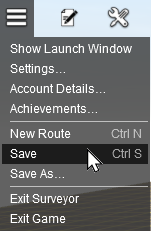 |
 |
Selecting Save or pressing Ctrl + S will save the route, or the route and the session, with the previously entered name(s) when they were loaded or created. You will be asked to confirm both the names (and can change them if you wish) and the Save command.
|
 |
Selecting Save As... will save the route, or the route and the session, with the previously entered name(s) when they were loaded or created. You will be asked to confirm both the names (and can change them if you wish) and the Save As command.
|
 |
Notes:
|
|
|
|
 |
Notes on Saving DLS/DLC Routes and Sessions:
|
| |
| DLS Routes and Sessions can be modified and saved as new routes and sessions |
 |
Modifying and Creating:-
 |
if you have modified a DLS route then you can delete the original route if you no longer need it and your modified version will not be affected |
 |
if you have modified a DLS session then you can delete the original session if you no longer need it and your modified version will not be affected. However, if you delete the original DLS route then your modified session will not work |
 |
you can create a completely new and original session for a DLS route but it will not work if the original DLS route is deleted |
 |
the original DLS routes and sessions will not be altered or replaced by your modified versions |
|
 |
Saving:-
 |
when saved, modified DLS routes and sessions will become Your Content and can be found using the MY CONTENT search option in Surveyor/Driver |
|
 |
Uploading:-
 |
you can only upload your modified DLS route and session to the DLS if you have the permission of the original creator |
 |
if you have created a completely original session based on a DLS route then you can upload the session as it is your creation |
|
|
| |
DLC Routes and Sessions can also be modified and saved as new routes and sessions ONLY if the creators of the original DLC content have allowed it - see  Cloning a Route/Session below for more details Cloning a Route/Session below for more details |
 |
Modifying and Creating:-
 |
some DLC routes and sessions are encrypted and cannot be modified - that is a decision made by the content creator |
 |
your modified DLC route or session will become an alias of the original and will need the original route and session to be present on your system to work |
 |
if you delete or disable the original DLC route or session then your modified versions will not work |
 |
you can create a completely new and original session for a DLC route but it will not work if the original DLC route is deleted or disabled |
 |
the original DLC routes and sessions will not be altered or replaced by your modified versions |
|
 |
Saving:-
 |
when saved, a modified DLC route or session will become Your Content and can be found using the MY CONTENT search option in Surveyor/Driver |
 |
the original DLC route and session will not be altered or replaced by your modified versions |
|
 |
Uploading:-
 |
you can upload your modified DLC route or session to the DLS but it can only be used by those who also have the same original (unmodified) DLC version installed |
|
|
Saving a New Route and Session
|
 |
 |
|
|
|
|
If you have created a new route and select Save or Save As..., then you will be presented with the following Save Route Dialogue Windows.
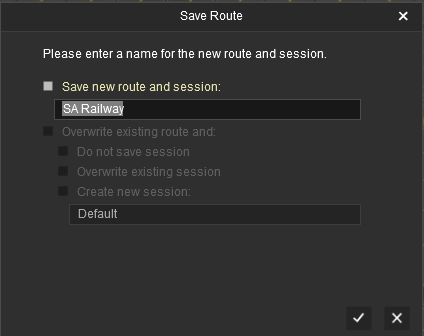 |
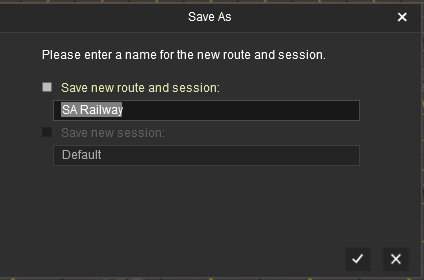 |
| In both cases the name of the route that was entered when it was created will be shown and you can change the name, even in the Save option. However, there is no option in either case to change the name of the created session because the other options have been greyed out and cannot be selected. |
Saving an Existing Route
|
 |
 |
|
|
|
|
| If you have loaded the route only and not the session and HAVE NOT edited any Session Data or Session Layers, then selecting Save will produce the following Save Route Dialogue Window. |
| If you have loaded the route only and not the session and HAVE edited Session Data or Session Layers, then selecting Save will produce the following Save Route Dialogue Window. |
 |
Notes:
|
 |
If you have edited any session Data or Layers but have selected the option Do not save session then later, before you exit the program, you will be prompted to save the edited session by the appearance of the Save Session dialogue box (see below). |
 |
If you decide to create a new session and leave its name as Default then a new Default Session will be created to add to any others also named Default that may already be present in a route and this will cause confusion. This is why it is not a good idea to use Default as a session name. |
|
Saving an Existing Route and Session
|
 |
 |
|
|
|
|
| If you have loaded a route and a session and have edited the route OR both the route AND the session, then selecting Save will produce the following Save Route Dialogue Window. |
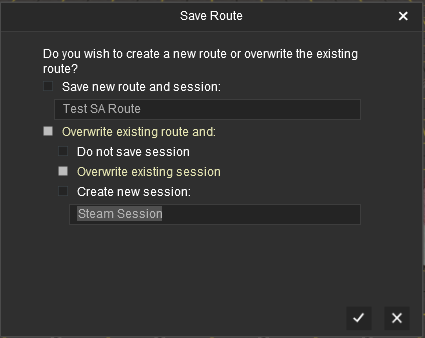 |
|
 |
Notes:
|
 |
If you have edited any session Data or Layers but have selected the option Do not save session then later, before you exit the program, you will be prompted to save the edited session by the appearance of the Save Session dialogue box (see below). |
 |
If you decide to create a new session and leave its name as Default then a new Default Session will be created to add to any others also named Default that may already be present in a route and this will cause confusion. This is why it is not a good idea to use Default as a session name. |
 |
There is a BUG in Trainz Plus and TRS22 that will treat changing the name of a Track Object (e.g. a signal, track mark, switch, etc) as a change to the session and not to the route. If you have not edited anything else in the route then you will see the Session Save dialogue window (see  Saving an Edited Session Only below) to save the session and not the route. The workaround is to make a change to the route (e.g. move a tree a few centimetres) and select save again. Saving an Edited Session Only below) to save the session and not the route. The workaround is to make a change to the route (e.g. move a tree a few centimetres) and select save again. |
|
Saving an Edited Session Only
|
 |
 |
|
|
|
|
 |
If you have only edited the session then you will be given the option to save the Session only |
| If you have loaded a route and a session and have edited the session (Data or Layers) only and not the route, or have already saved the route but not the session, then selecting Save will produce the following Save Session Dialogue Window. |
Saving a Route and Session Using the UDS
|
 |
 |
|
|
|
|
 |
The UDS feature is available in TRS19 Platinum Edition, Trainz Plus, TRS22 and TRS22 Platinum |
| The UDS (Unified Driver Surveyor) Interface allows you to quickly switch from Driver to Surveyor and back to Driver again without having to restart the session from the beginning. You can edit a route and session while in Surveyor and then switch back to Driver to continue the session where you left it. |
 |
WARNING:
This powerful ability does come with a warning. If you save the edited session before switching back into Driver then all the moving consists will be saved in their new positions. Other changes, such as the status of Session Rules, will also be saved in their new states. See the Trainz Wiki Page  How to Use the UDS Interface for more details. How to Use the UDS Interface for more details.
|
|
| Most of the problems users seem to be experiencing with the UDS, judging from the posts in the Trainz Forums, is when saving their edited Driver session after switching to Surveyor mode. |
 |
Notes:
|
 |
Using Driver Mode involves driving consists (either manually or through the AI) and activating rules. These will change the session parameters |
 |
Overwriting the Session will save the consist in their new positions and the Session Rules in their new (completed/not completed) conditions |
 |
When you are in Driver Mode at least one of the consists will probably be moving. Some of the Session rules may have already been completed while others may still be running or waiting for events (e.g. triggers to be activated) |
 |
If, after switching to Surveyor Mode, you then choose to save using the Overwrite existing session option then you will be replacing your original starting Session with a new one with the consists saved in their new positions and the Session rules saved in their new states. So when you later load and restart the Session things will not be the same as they were in the original or starting Session. |
|
Unless you have a particular reason for overwriting the original Session then the recommended save options are:-
|
If you have NOT edited anything while in Surveyor and select Save then you will be shown the Save Driver Session dialogue window to save the session in its current state as a Driver Game (also called a Game or Driver Game). This is exactly the same as pressing Ctrl + S while in Driver.
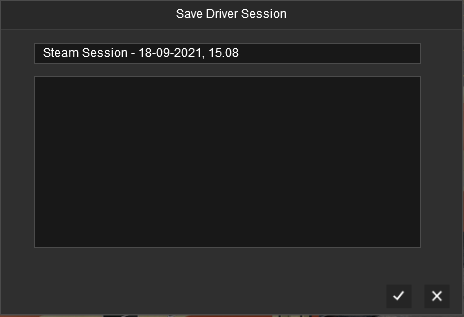
The Driver Game will appear in the Select Session menu for the route. Loading it will resume Driver at the point where it was saved. |
 |
If you exit Surveyor after editing without saving then you will be prompted to Save. |
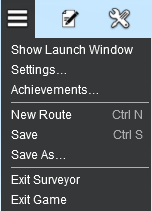 |
Steps:
 |
Open the Main Menu |
 |
select the Exit Surveyor option |
| Another option is to exit Trainz completely |
 |
select the Exit Game option |
| Regardless of which option you take, if you have unsaved work you will be prompted to save before you exit |
|
|
|
| Unsaved Route |
Unsaved Session |
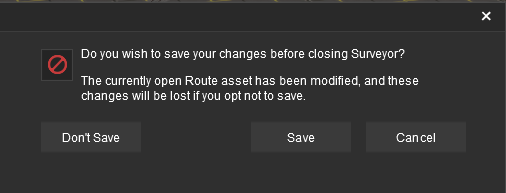 |
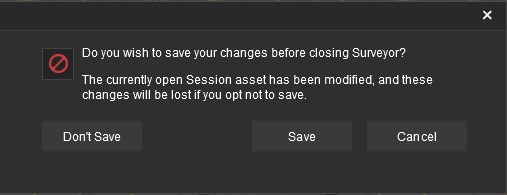 |
| Options: |
 |
Don't Save will exit Surveyor to either the Main Menu Screen or to your OS Desktop without saving. Any changes you have made will be lost. |
 |
Save will exit Surveyor to either the Main Menu Screen or to your OS Desktop after saving. You will be prompted to select what to save as described in the section  Saving a Route and a Session above Saving a Route and a Session above |
 |
Cancel will cancel the Exit command and return you to Surveyor. |
|
 |
If you exit Driver after running a session you will be prompted to Save a Driver Game. |
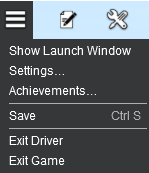 |
Steps:
 |
Open the Main Menu |
 |
select the Exit Driver option |
| Another option is to exit Trainz completely |
 |
select the Exit Game option |
| Regardless of which option you take, if your Session Data has changed then you will be prompted to save before you exit |
|
|
|
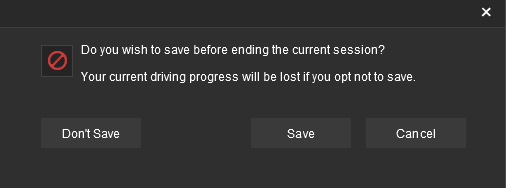
| Options: |
 |
Don't Save will exit Driver to either the Main Menu Screen or to your OS Desktop without saving. The current state of the session (positions and movements of the consists, commodity levels, time of day, etc) will be lost. |
 |
Save will exit Driver to either the Main Menu Screen or to your OS Desktop sfter saving. You will be prompted to enter a name for your saved Driver Game. See the section  Saving Driver Games below for more details. Saving Driver Games below for more details. |
 |
Cancel will cancel the Exit command and return you to Driver. |
|
 |
A Clone is an exact or duplicate copy of an asset. Some Payware routes and sessions cannot be cloned |
 |
Cloned routes and sessions can be edited and saved as Your Content |
| Cloning a Route or a Session allows you to work on a duplicate copy of the original. All changes that you make will be saved in the cloned copy leaving the original copy unchanged. |
 |
Cloned assets are subject to copyright laws and they remain the property of the original creator
|
|
 |
Notes:
|
 |
Freeware routes, that have been downloaded and installed from the DLS, can be cloned and saved as new routes.
 |
They are saved with a new <kuid> that will include your personal identity code, so they will become Your Content and can be found using the MY CONTENT search option |
 |
The original route from the DLS will not be altered or replaced by your new version |
 |
You can delete the original DLS route if you wish and your cloned version will NOT be affected |
|
 |
Payware Routes, that have been downloaded and installed from the DLC, can also be cloned as new routes if the creators of the routes allow it.
 |
Some Payware routes are encrypted and cannot be cloned |
 |
When an approved DLC route is cloned it will be given a new <kuid> that will include your personal identity code, so it will become Your Content and can be found using the MY CONTENT search option |
 |
The original Payware route will not be altered or replaced by your new version |
 |
If you delete or disable the original DLC route then your cloned route will NOT work |
 |
You can upload, depending on permissions, your edited clone of a Payware route to the DLS but it can only be used by other users who also have the same original (unedited) DLC Payware route installed |
|
 |
Sessions that have been downloaded and installed from the DLS (freeware) or DLC (payware) follow the same rules as described for DLS and DLC routes above
 |
Some Payware sessions are encrypted and cannot be cloned |
 |
When an approved DLC session is cloned it will be given a new <kuid> that will include your personal identity code, so it will become Your Content and can be found using the MY CONTENT search option |
 |
The original DLC or DLS session will not be altered or replaced by your new version |
 |
You can, if you decide, safely delete the original DLS session but not the original DLS route |
 |
If you delete or disable the original DLC session or the original DLC route then your cloned session will NOT work |
 |
You can upload, depending on permissions, your edited clone of a Payware session to the DLS but it can only be used by other users who also have the same original (unedited) DLC Payware installed. |
|
|
Cloning Using Surveyor
|
 |
 |
|
|
|
|
| Routes and Sessions that have been loaded into Surveyor can be cloned using the Save As... command from the Surveyor System Menu |
| Enter a new name or edit the original name (as shown above) for your cloned route or session. |
| Options: |
 |
If the first option ( Save new route and session) is selected then the Route will be cloned using your new or edited name. The Session will be also cloned using its original name but it will use the newly cloned Route as a dependency instead of the original Route. Save new route and session) is selected then the Route will be cloned using your new or edited name. The Session will be also cloned using its original name but it will use the newly cloned Route as a dependency instead of the original Route.
 |
If the original route is Freeware (e.g. from the DLS) and you do not want to keep it then it can be safely deleted, which will also delete the original session but the new cloned route and session will remain active on your system |
 |
If the original route is Payware (e.g. from the DLC) then deleting or disabling it will disable your cloned route and session. When Payware is cloned it must remain active on your system for the clone to work.
|
|
 |
If the second option ( Save new session) is selected then only the Session will be cloned using your new or edited name (make sure that you change the "Default" to something else) but it will still use the original (uncloned) Route as a dependency - so it is vital that you DO NOT DELETE the original route. Save new session) is selected then only the Session will be cloned using your new or edited name (make sure that you change the "Default" to something else) but it will still use the original (uncloned) Route as a dependency - so it is vital that you DO NOT DELETE the original route.
 |
If the original session is Freeware then it can be safely deleted if you no longer need it |
 |
If the original session is Payware then deleting or disabling it will also disable your cloned session |
|
|
Cloning Using Content Manager
|
 |
 |
|
|
|
|
 Select the Route or Session to Clone Select the Route or Session to Clone |
A Task Window will open to display the result.
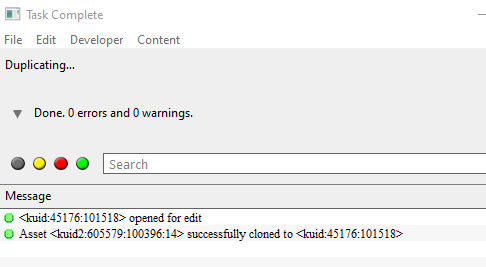
In the image above the original Route has been cloned and given a new <kuid> value.
The newly cloned Route will be shown in Content Manager as a New Asset that is Open for Editing. |
Steps:
 |
close the Task Window |
 |
select the Open for Editing filter. |
|
|

 Rename the Clone (an Optional Step) Rename the Clone (an Optional Step)
You can give the cloned Route or Session a new name and a new description. Note that these changes will not appear until after the New Asset has been submitted. |
 Submit the Clone (a Necessary Step) Submit the Clone (a Necessary Step) |
 |
When submitted a cloned DLC Route or Session will be described as Payware, Modified while a cloned DLS Route or Session will be described as Modified |
Steps:
 |
Right Click on the New Asset |
 |
select the option Submit Edits |
The New Asset entry will vanish from the Open for Editing display. Open the Content Manager filter Today to check that it has been correctly submitted. If you have renamed the clone then it should appear using its new name.
|
|
 |
Notes:
You can rename a cloned Route or a cloned Session in Surveyor but the clone would still have to be submitted in Content Manager first using its original name and then loaded into Surveyor. You would then have two Routes or Sessions with the same name to select from - one would be the original and the other the clone, and telling them apart may not be simple. You can use the Driver/Surveyor main screen MY CONTENT source filter to locate and load the correct cloned Route or Session because the clone will have your <kuid> code and not its original code.
|
|
Saving and Loading Driver Games in Driver
|
 |
 |
 |
 |
 |
 |
 |
Driver Games (sometimes called "Saved Games" or "Driver Sessions") are "Game States" saved while in Driver Mode |
 |
Notes:
| Driver Games:- |
 |
like routes and sessions, are saved as entries in the Trainz Database, not as files on your hard drive. Loading a driver game will retrieve it from the database. |
 |
can be loaded directly into Driver from Content Manager in exactly the same way that Sessions can be loaded directly into Driver from Content Manager |
 |
can be exported as files (in the Trainz .cdp file format) from Content Manager for backup or transfer. |
|
|
Saving Driver Games
|
 |
 |
|
|
|
|
Driver Games save the "state of play" in Driver - the position of consists, the commodities and levels in rolling stock and industries, the state of the Driver Command queues, Session Rules, clock time, etc. Once saved, the Driver Game can be loaded back into Driver to continue the play at the point where it was saved.
When you are in Driver select Save from the System Menu or press Ctrl + S .
This will display the Save Driver Session dialogue window showing the name of the current session with a date and time stamp (shown left below). If you Left Click pn the Tick then this will be the name used for the saved game. Alternatively, you could enter your own unique name (shown right below).
The space below the entered name will display any other saved driver games for that session. |
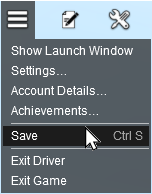 |
Loading Driver Games
|
 |
 |
|
|
|
|
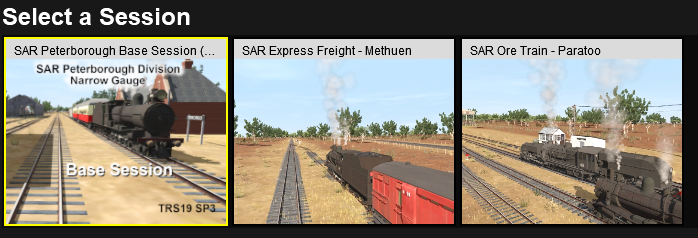
 |
Notes:
|
 |
Where a route has multiple sessions and driver games they will all be shown by their thumbnails with no way of telling which driver games belong to which session. |
 |
It can also be difficult to tell which thumbnail is a session and which is a Driver Game, especially if you have removed the date/time stamp Trainz automatically adds to the name of a Driver Game. A simple way to tell is to Left Click on a thumbnail to see if the EDIT SESSION button is still visible. If it is not, because driver games cannot be edited, then the thumbnail is for a Driver Game.
|
|
Where there is only one session in a route, the session will be the first thumbnail shown in the list followed by the driver games. Note that the session is selected by default.
Select (hightlight) the Driver Game you want to load and then Left Click on the DRIVE SESSION button.

This will load the Driver Game, the session and the route into Driver. |
 |
If you load a Driver Game after you have edited the original route or session that was used to create it, then you will receive a message warning you that changes have been made to the original assets. The changes could affect the operation of the Driver Game.
 |
If you have opened the Driver Game in Driver directly from Content Manager then you will not be given this warning |
|
| |
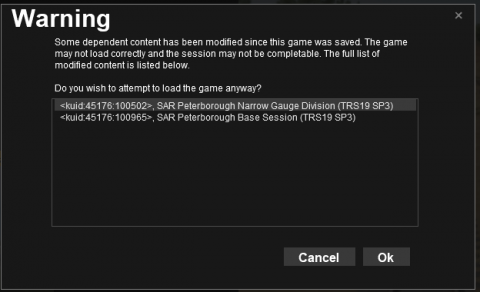 |
Options:-
 |
Cancel - the Driver Game will NOT be loaded, OR |
 |
Ok - load the Driver Game wirh the changes |
If the changes to the route or session have been:-
 |
minor and non-operational, such as scenery assets (trees, buildings, etc) then the Driver Game can be safely loaded. |
 |
more significant operational changes, such as triggers, trackmarks, active industries, consists, tracks, etc, then it may NOT be wise to load and run the Driver Game. |
Only you can be the judge but I would err on the side of caution
|
|
|
Editing Driver Games
|
 |
 |
|
|
|
|
| It is possible to load and edit a saved Driver Game in versions of Trainz that have the UDS (Unified Driver Surveyor) interface - these versions are TRS19 Platinum, Trainz Plus, TRS22 and TRS22 Platinum. However, when you save your edit, it will NOT be saved as an update to the loaded Driver Game. Instead it will be saved as a Session. You can select to create a new session or to overwrite the original session. |
The Session will be saved with all the:-
 |
consists in their positions and states (stationary or moving) at the time of the save |
 |
industries and rolling stock in their conditions (e.g. product levels) at the time of the save |
 |
switches in their state at the time of the save, and |
 |
session rules in their state (completed or not completed) at the time of the save |
Deleting Routes and Sessions
|
|
 |
 |
 |
|
 |
 |
Deleting a Route will delete that Route, all its Sessions and all its Driver Games (if any) |
 |
Deleting a Session will delete that Session and its Driver Games (if any). It will NOT delete the Route it was created from. It will NOT delete other Sessions created for that Route. It will NOT delete any other Driver Games created for those other Sessions |
 |
Deleting a Driver Game will only delete that Driver Game. It will NOT delete the Route or Session it was created from or any other Driver Games from that Session |
| All the Surveyor and Driver screens for loading routes and sessions have a DELETE ... button as an option. |
| |
WARNING: |
 |
If you delete a Route you will also delete all the Sessions and Driver Games created using that Route
|
 |
If you delete a Session you will also delete all the Driver Games created using that Session
|
|
If you need a more selective way of deleting routes, sessions and driver games, then use Content Manager from the Trainz Launch Screen. Select the Filter Routes & Sessions.
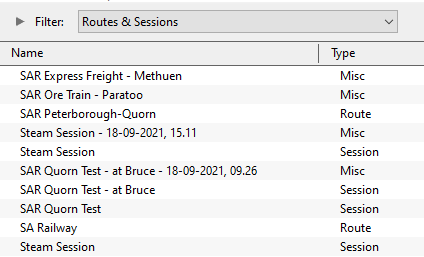
The Type column will identify each entry as a route, session or Misc. Misc in this case means a saved Driver Game.
You can delete routes and/or sessions individually but if you delete a route by itself then its dependant sessions and driver games will be shown as faulty with Missing dependencies. Likewise, if you delete a session by itself then its dependant driver games will be shown as faulty with Missing dependencies. |
Trainz Wiki
 |
Route and Session Building Guides
|
| |
More Tutorials and Guides to Using Trainz
|
|
 |
Related Links
|
|
This page was created by Trainz user pware in September 2021 and was last updated as shown below.




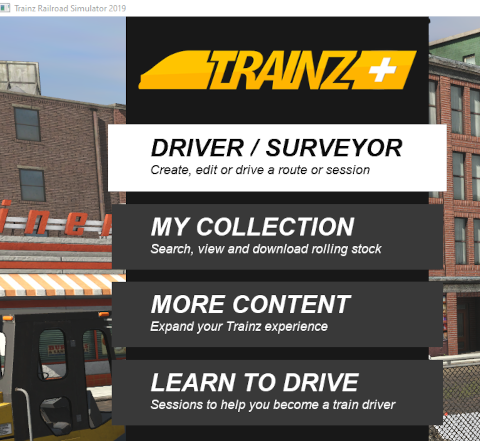

![]()
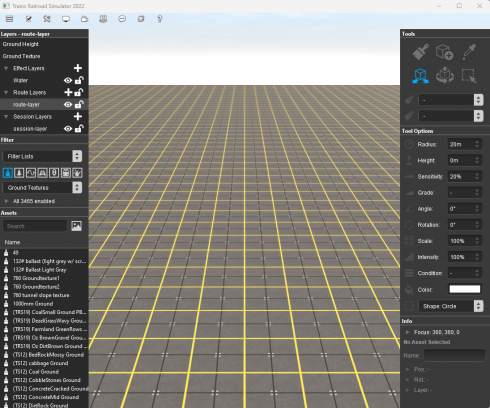






![]()

![]()

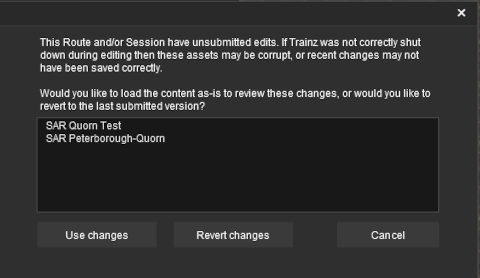

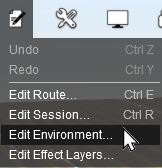

![]() Session Data:
Session Data:




![]()
Saving and Loading Sessions in Driver below.
